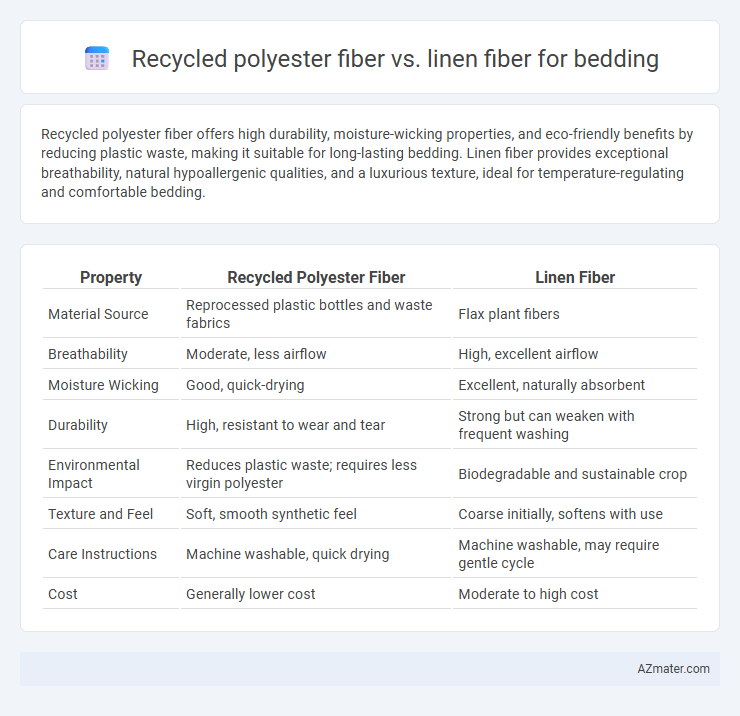Recycled polyester fiber offers high durability, moisture-wicking properties, and eco-friendly benefits by reducing plastic waste, making it suitable for long-lasting bedding. Linen fiber provides exceptional breathability, natural hypoallergenic qualities, and a luxurious texture, ideal for temperature-regulating and comfortable bedding.
Table of Comparison
| Property | Recycled Polyester Fiber | Linen Fiber |
|---|---|---|
| Material Source | Reprocessed plastic bottles and waste fabrics | Flax plant fibers |
| Breathability | Moderate, less airflow | High, excellent airflow |
| Moisture Wicking | Good, quick-drying | Excellent, naturally absorbent |
| Durability | High, resistant to wear and tear | Strong but can weaken with frequent washing |
| Environmental Impact | Reduces plastic waste; requires less virgin polyester | Biodegradable and sustainable crop |
| Texture and Feel | Soft, smooth synthetic feel | Coarse initially, softens with use |
| Care Instructions | Machine washable, quick drying | Machine washable, may require gentle cycle |
| Cost | Generally lower cost | Moderate to high cost |
Introduction to Sustainable Bedding Materials
Recycled polyester fiber, derived from post-consumer plastic waste, offers a sustainable bedding option by reducing landfill waste and energy consumption compared to virgin polyester. Linen fiber, made from flax plants, is a natural, biodegradable material known for its breathability, durability, and minimal environmental impact due to low water and pesticide requirements. Both fibers contribute to eco-friendly bedding solutions, with recycled polyester emphasizing waste reduction and linen prioritizing renewable, organic cultivation.
Overview of Recycled Polyester Fiber
Recycled polyester fiber is made from post-consumer plastic bottles and industrial polyester waste, offering an eco-friendly alternative to virgin polyester by reducing landfill waste and lowering carbon emissions. It features high durability, moisture-wicking properties, and resistance to wrinkles, making it suitable for long-lasting, low-maintenance bedding. In contrast to natural fibers like linen, recycled polyester provides greater abrasion resistance and quicker drying times, enhancing comfort and longevity in bedding applications.
Overview of Linen Fiber
Linen fiber, derived from the flax plant, is renowned for its natural breathability, moisture-wicking properties, and durability, making it highly suitable for bedding. Its hypoallergenic and antimicrobial characteristics promote a healthy sleeping environment, appealing to eco-conscious consumers seeking sustainable alternatives to synthetic fibers. Unlike recycled polyester fiber, linen offers superior temperature regulation and biodegradability, enhancing both comfort and environmental impact in bedding products.
Environmental Impact Comparison
Recycled polyester fiber significantly reduces plastic waste by repurposing PET bottles, decreasing landfill accumulation and lowering carbon emissions compared to virgin polyester production. Linen fiber, derived from flax plants, offers a biodegradable and renewable alternative with minimal water and pesticide use, resulting in a smaller environmental footprint across cultivation and processing. Although recycled polyester helps mitigate plastic pollution, linen's natural biodegradability and lower resource demand make it a more sustainable choice for eco-conscious bedding products.
Comfort and Breathability
Recycled polyester fiber offers durability and moisture-wicking properties but tends to retain heat, making it less breathable compared to linen fiber. Linen fiber excels in comfort with its natural breathability and moisture-absorbing capabilities, providing a cooler sleep experience. The porous structure of linen promotes airflow, reducing night sweating and enhancing overall bed comfort.
Durability and Longevity
Recycled polyester fiber offers superior durability and resistance to wear, making it ideal for bedding that withstands frequent washing and extended use. Linen fiber, known for its natural strength and breathability, provides long-lasting comfort but may develop a softer, more delicate texture over time. Choosing between these fibers depends on prioritizing either enhanced longevity with minimal maintenance (recycled polyester) or eco-friendly, breathable durability with natural aging qualities (linen).
Maintenance and Care Requirements
Recycled polyester fiber bedding offers superior resistance to wrinkles, stains, and moisture, requiring minimal maintenance such as simple machine washing and quick drying without special care products. Linen fiber bedding demands more delicate handling, including gentle washing, avoiding bleach, and frequent ironing to maintain its textured appearance and durability. Choosing recycled polyester minimizes upkeep time and costs, while linen offers breathability but requires attentive care to preserve its quality.
Cost Considerations
Recycled polyester fiber offers a cost-effective option for bedding due to its lower production expenses and affordability compared to natural fibers. Linen fiber, derived from flax plants, usually commands a higher price because of its labor-intensive cultivation and processing methods. Budget-conscious consumers often prefer recycled polyester for its durability and maintenance ease, while those willing to invest more may choose linen for its breathability and natural texture.
Allergen and Skin Sensitivity Factors
Recycled polyester fiber offers hypoallergenic properties due to its resistance to dust mites and mold, making it suitable for individuals with allergies and sensitive skin. Linen fiber is naturally breathable and moisture-wicking, reducing the likelihood of skin irritation and allergic reactions by keeping the bedding dry and cool. Both materials support skin health, but linen's natural fibers provide superior ventilation, which can be beneficial for those prone to eczema or sensitive skin conditions.
Final Verdict: Choosing the Best Bedding Material
Recycled polyester fiber offers durability, moisture-wicking properties, and eco-friendliness by reducing plastic waste, making it a practical choice for budget-conscious and sustainable bedding. Linen fiber excels in breathability, natural temperature regulation, and hypoallergenic qualities, providing a luxurious sleep experience ideal for hot climates and sensitive skin. For optimal bedding, preference depends on environmental priorities and comfort needs, with recycled polyester favored for sustainability and linen praised for natural comfort and longevity.

Infographic: Recycled polyester fiber vs Linen fiber for Bedding
 azmater.com
azmater.com